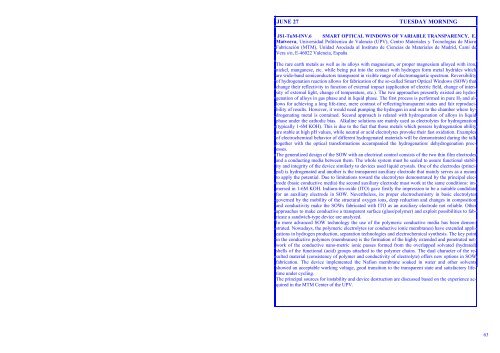Wüest M. 51 Wykes M. 82 Yamaguchi M. 17 Ybarra G. 129 Yubero F ...
Wüest M. 51 Wykes M. 82 Yamaguchi M. 17 Ybarra G. 129 Yubero F ...
Wüest M. 51 Wykes M. 82 Yamaguchi M. 17 Ybarra G. 129 Yubero F ...
You also want an ePaper? Increase the reach of your titles
YUMPU automatically turns print PDFs into web optimized ePapers that Google loves.
JUNE 27 TUESDAY MORNING<br />
JS1-TuM-INV.6 SMART OPTICAL WINDOWS OF VARIABLE TRANSPARENCY. E.<br />
Matveeva, Universidad Politécnica de Valencia (UPV), Centro Materiales y Tecnologías de Micro<br />
Fabricación (MTM), Unidad Asociada al Instituto de Ciencias de Materiales de Madrid, Cami de<br />
Vera s/n, E-46022 Valencia, España<br />
The rare earth metals as well as its alloys with magnesium, or proper magnesium alloyed with iron,<br />
nickel, manganese, etc. while being put into the contact with hydrogen form metal hydrides which<br />
are wide-band semiconductors transparent in visible range of electromagnetic spectrum. Reversibility<br />
of hydrogenation reaction allows for fabrication of the so-called Smart Optical Windows (SOW) that<br />
change their reflectivity in function of external impact (application of electric field, change of intensity<br />
of external light, change of temperature, etc.). The two approaches presently existed are hydrogenation<br />
of alloys in gas phase and in liquid phase. The first process is performed in pure H 2 and allows<br />
for achieving a long life-time, mere contrast of reflecting/transparent states and fair reproducibility<br />
of results. However, it would need pumping the hydrogen in and out to the chamber where hydrogenating<br />
metal is contained. Second approach is related with hydrogenation of alloys in liquid<br />
phase under the cathodic bias. Alkaline solutions are mainly used as electrolytes for hydrogenation<br />
(typically 1-6M KOH). This is due to the fact that those metals which possess hydrogenation ability<br />
are stable at high pH values, while neutral or acid electrolytes provoke their fast oxidation. Examples<br />
of electrochemical behavior of different hydrogenated materials will be demonstrated during the talk<br />
together with the optical transformations accompanied the hydrogenation/ dehydrogenation processes.<br />
The generalized design of the SOW with an electrical control consists of the two thin film electrodes<br />
and a conducting media between them. The whole system must be sealed to assure functional stability<br />
and integrity of the device similarly to devices used liquid crystals. One of the electrodes (principal)<br />
is hydrogenated and another is the transparent auxiliary electrode that mainly serves as a means<br />
to apply the potential. Due to limitations toward the electrolytes demonstrated by the principal electrode<br />
(basic conductive media) the second auxiliary electrode must work at the same conditions: immersed<br />
in 1-6M KOH. Indium-tin-oxide (ITO) gave firstly the impression to be a suitable candidate<br />
for an auxiliary electrode in SOW. Nevertheless, its proper electrochemistry in basic electrolytes<br />
governed by the mobility of the structural oxygen ions, deep reduction and changes in composition<br />
and conductivity make the SOWs fabricated with ITO as an auxiliary electrode not reliable. Other<br />
approaches to make conductive a transparent surface (glass/polymer) and exploit possibilities to fabricate<br />
a sandwich-type device are analyzed.<br />
In more advanced SOW technology the use of the polymeric conductive media has been demonstrated.<br />
Nowadays, the polymeric electrolytes (or conductive ionic membranes) have extended applications<br />
in hydrogen production, separation technologies and electrochemical synthesis. The key point<br />
in the conductive polymers (membranes) is the formation of the highly extended and penetrated network<br />
of the conductive nano-metric ionic passes formed from the overlapped solvated (hydrated)<br />
shells of the functional (acid) groups attached to the polymer chains. The dual character of the resulted<br />
material (consistency of polymer and conductivity of electrolyte) offers new options in SOW<br />
fabrication. The device implemented the Nafion membrane soaked in water and other solvents<br />
showed an acceptable working voltage, good transition to the transparent state and satisfactory lifetime<br />
under cycling.<br />
The principal sources for instability and device destruction are discussed based on the experience acquired<br />
in the MTM Center of the UPV.<br />
63
















